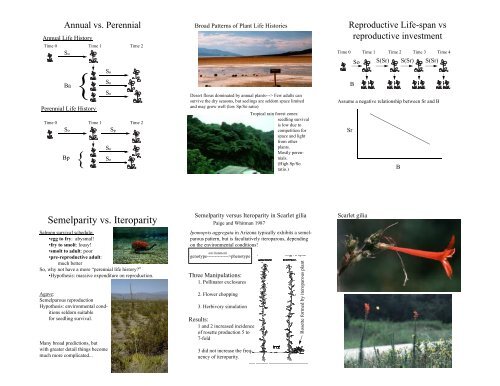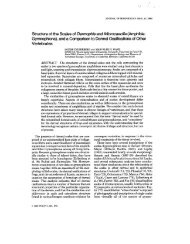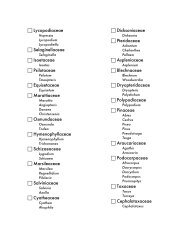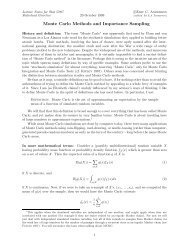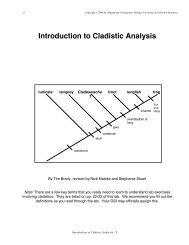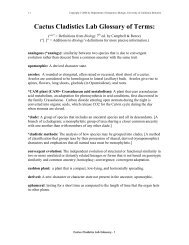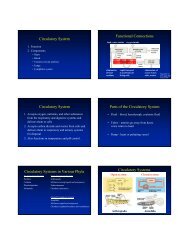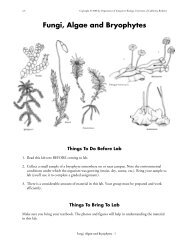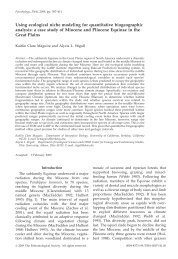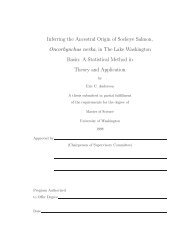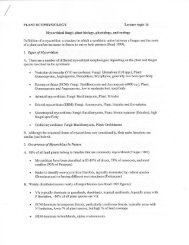Semelparity vs. Iteroparity
Semelparity vs. Iteroparity
Semelparity vs. Iteroparity
Create successful ePaper yourself
Turn your PDF publications into a flip-book with our unique Google optimized e-Paper software.
Annual <strong>vs</strong>. Perennial<br />
Annual Life History<br />
Time 0 Time 1<br />
So<br />
Ba<br />
{<br />
Perennial Life History<br />
Time 0 Time 1<br />
So<br />
Bp<br />
{<br />
So<br />
So<br />
So<br />
So<br />
So<br />
Sp<br />
Time 2<br />
Time 2<br />
<strong>Semelparity</strong> <strong>vs</strong>. <strong>Iteroparity</strong><br />
Salmon survival schedule:<br />
•egg to fry: abysmal!<br />
•fry to smolt: lousy!<br />
•smolt to adult: poor<br />
•pre-reproductive adult:<br />
much better<br />
So, why not have a more “perennial life history?”<br />
•Hypothesis: massive expenditure on reproduction.<br />
Agave:<br />
Semelparous reproduction<br />
Hypothesis: environmental conditions<br />
seldom suitable<br />
for seedling survival.<br />
Many broad predictions, but<br />
with greater detail things become<br />
much more complicated...<br />
Broad Patterns of Plant Life Histories<br />
Desert floras dominated by annual plants---> Few adults can<br />
survive the dry seasons, but seelings are seldom space limited<br />
and may grow well (low Sp/So ratio)<br />
Tropical rain forest zones:<br />
seedling survival<br />
is low due to<br />
competition for<br />
space and light<br />
from other<br />
plants.<br />
Mostly perennials.<br />
(High Sp/So<br />
ratio.)<br />
<strong>Semelparity</strong> versus <strong>Iteroparity</strong> in Scarlet gilia<br />
Paige and Whitman 1987<br />
Ipomopsis aggregata in Arizona typically exhibits a semelparous<br />
pattern, but is facultatively iteroparous, depending<br />
on the environmental conditions!<br />
environment<br />
genotype-------------->phenotype<br />
Three Manipulations:<br />
1. Pollinator exclosures<br />
2. Flower chopping<br />
3. Herbivory simulation<br />
Results:<br />
1 and 2 increased incidence<br />
of rosette production 5 to<br />
7-fold<br />
3 did not increase the frequency<br />
of iteroparity.<br />
Rosette formed by iteroparous plant<br />
Reproductive Life-span <strong>vs</strong><br />
reproductive investment<br />
Time 0 Time 1<br />
B<br />
So<br />
S(Sr)<br />
Time 2<br />
S(Sr)<br />
Time 3<br />
S(Sr)<br />
Assume a negative relationship between Sr and B<br />
Sr<br />
Scarlet gilia<br />
B<br />
Time 4
Phenotypic Plasticity<br />
Some terms and defns<br />
Canalization: one genotype produces a single phenotype,<br />
regardless of environment<br />
Phenotypic plasticity: a general term covering all types of<br />
environmentally induced phenotypic variation<br />
Polyphenism: a type of phenotypic plasticity in which the<br />
change is between two or more discrete phenotypes:<br />
•environmental sex determination<br />
•castes of social insects<br />
•locust behavior (isolated/sedentary <strong>vs</strong>. gregarious)<br />
•semelaparity or iteroparity in Gilia<br />
Reaction norm: the continuous relationship between a<br />
trait changing due to phenotypic plasticity, and some<br />
feature of the environment.<br />
“A mirror that reflects environmental effects into<br />
phenotypes”<br />
With all this phenotypic plasticity, how can natural selection<br />
“grab onto” different genotypes?<br />
Phenotype<br />
3<br />
1<br />
2<br />
Reaction Norms<br />
1 2 3<br />
Environment<br />
Curves representing<br />
different genotypes<br />
G x E interaction: when reaction norms for different<br />
genotypes cross<br />
•Expected to be pervasive (Stearns 1989)<br />
•Are commonly observed<br />
•Due to trade-offs?<br />
The reaction norm itself is under genetic control!<br />
This is how natural selection can “grab” the genotype,<br />
even in the presence of phenotypic plasticity<br />
Predator Induced Phenotypic Plasticity<br />
Daphnia grow thicker and<br />
spinier helmets in the presence<br />
of compounds associated with<br />
their predators<br />
Helmet<br />
Also:<br />
Thais lamellosa,<br />
the fringed dogwhelk.<br />
An aquatic<br />
snail that drifts as<br />
a planktonic larval<br />
veliger. If it<br />
“lands” in an area<br />
with Cancer<br />
productus (a crab<br />
predator) it<br />
develops a thicker<br />
shell.<br />
Chaoborus, a Daphnia predator<br />
Comparative Study of Reaction Norms in Lizards<br />
2 lizard species<br />
Sinervo & Adolph 1994<br />
Sceloporus occidentalis<br />
Sceloporus graciosus<br />
•Taken from three different elevations (low, med, high) in CA<br />
and one population from OR.<br />
•High elevation/latitude populations have fewer active hours<br />
•Activity = body temp high enough for growth to occur<br />
•Hatchlings raised in 4 expmtal condns: 6, 9, 12, and 15 hours<br />
of potential activity time. (Incandescent light bulb)<br />
•Results: 1) Short-day specialists (high altitude/latitude lizards)<br />
growth rate did not increase with >9 hr of potential activity<br />
2) Lower elevation lizards could capitalize on longer potential<br />
activity days in the laboratory<br />
3) Among family variation in reaction norms<br />
4) Family x treatment interaction-->G x E interaction<br />
Prey-induced plasticity<br />
Cichlid fishes fed<br />
different diets<br />
developed different jaw<br />
morphologies. These<br />
changes were<br />
reversible.<br />
(Meyer 1987)<br />
Grasshopper mandible<br />
morphology changes<br />
in response to diet.<br />
•Soft leaves versus<br />
hard leaves<br />
•Having the right mandibles<br />
makes a<br />
difference in energy<br />
accumulation.<br />
(Thompson 1988)<br />
Evolutionary Theories of<br />
Aging and Senescence<br />
Some observations:<br />
Raised under good conditions with no predation risk:<br />
•Birds typically live longer than mammals<br />
•Bats typically live longer than terrestrial rodents<br />
•Flightless birds live shorter than flying birds<br />
•Thick-shelled bivalves live longer than other molluscs<br />
•Tortoises live longer than other reptiles<br />
Interesting Features:<br />
•Death occurs, eventually with certainty<br />
•Ideal-condition lifetimes vary greatly across taxa<br />
An Early Explanation for “Programmed Death” (by<br />
Wallace)<br />
“...when one or more individuals have provided a sufficient<br />
number of successors they themsleves, as consumers of<br />
nourishment in a constantly increasing degree, are an injury<br />
to those successors. Natural selection therefore weeds<br />
them out, and in many cases favours such reaces as die<br />
almost immediately after they have left successors”<br />
(quoted in Rose 1991).
Senescence<br />
•If you survive to a ripe old age:<br />
•Shouldn’t your extra experience increase your<br />
probability of survival into the future?<br />
•Maybe so, but it doesn’t work that way.<br />
•Senescence = greater susceptibility to injuries, disease,<br />
and death as one grows older<br />
•Neural degeneration<br />
•Reduction in kidney filtration<br />
•Decreased respiratory capacity, etc<br />
Environmental (proximate) causes<br />
•Sure, but senescence is still inevitable, it seems<br />
An evolutionary/genetic explanation: Medawar (1946)<br />
“What is important from our point of view is that the<br />
contribution which each age-class makes to the<br />
ancestry of the future decreases with age”<br />
The key is reduced selection on older age classes. This<br />
could lead to senescence by two mechanisms:<br />
1) antagonistic pleiotropy<br />
2) accumulation of late-acting mutations<br />
A 5-Minute Review<br />
Evolutionary Ecology covers themes from many different<br />
disciplines (which overlap themselves). Notably:<br />
Evolution:<br />
•Quantitative genetics, natural selection, sexual<br />
selection, phenotypic plasticity, kin-selection,<br />
life-history theory<br />
Behavioral Ecology:<br />
•Foraging theory, signalling, and reproductive<br />
behavior<br />
Sociobiology<br />
•Kin-selection, mating systems, territoriality<br />
We’ve encountered four main methods for interpreting<br />
variation in strategies in an evolutionary context:<br />
1. Optimality modeling (optimization ideas are<br />
ubiquitious in the field)<br />
•Most notable in Optimal Foraging Theory, but<br />
elements of it appear everywhere<br />
2. Game theoretic perspective (ESS’s)<br />
3. Comparative method<br />
4. Population/Quantitative genetic perspectives<br />
Antagonistic Pleiotropy<br />
Basic Premise: “Senescence later in life is the price of<br />
youthful vigor.”<br />
pleiotropy = when one gene affects two or more traits<br />
Williams (1957) “Selection of a gene that confers an<br />
advantage at one age and a disadvantage at another will<br />
depend not only on the magnitudes of the effects<br />
themselves, but also on the times of the effecgts. An<br />
advantage during the period of maximum reproductive<br />
probability would increase the total reproductive<br />
probability more than a proportionately similar<br />
disadvantage later on would decrease it.”<br />
Experimental Evidence:<br />
•Quantitative genetic correlations between early<br />
fecundity and longevity (sib analysis, line crosses)<br />
•Mendelian inherited, pleiotropically acting<br />
mutations:<br />
•C. elegans age-1 mutant (Friedman and<br />
Johnson 1988)<br />
•D. subobscura grandchildless mutation--female<br />
offspring have much longer lifespan, but<br />
no ovaries!<br />
Regarding the Exam<br />
•Covers everything from the first day of class.<br />
•It will be closed book, closed notes, closed handouts, etc.<br />
•Readings versus lectures:<br />
•You are expected to have done the readings, but won’t be asked<br />
questions of exasperating detail from them.<br />
The readings have been of two types:<br />
1) "textbook" type readings---sections of texts or edited volumes that<br />
describe general themes or methodologies. Typically in my lectures I<br />
have covered the aspects of those readings that I find most important<br />
and relevant. The lectures are a good indication of which parts of those<br />
readings to focus on. These readings serve to supplement lectures. Also,<br />
if it was a reading that you discussed in section, you should be quite<br />
comfortable with its general content.<br />
2) research articles---we've read quite a few of these. It's good to read<br />
these to get a sense of how research in evolutionary ecology is done and<br />
how its results are transmitted. Some of the articles were not discussed<br />
in lecture. Nonetheless for each article you should be able to tell me:<br />
(a) which of the general topics we have covered it is relevant to<br />
(b) the hypotheses that the authors were trying to test<br />
(c) the general methods---for example whether it was an observational<br />
study or a manipulation, what animals were studied, and what variables<br />
were observed<br />
(d) the general results; especially how the results relate to the general<br />
theory that the study is relevant to<br />
You should pay particular attention to those articles about which I talked<br />
at length in lecture.<br />
Mutation Accumulation<br />
Basic Premise: new, deleterious mutations build up in the<br />
genome. Such early-acting mutations are weeded out by<br />
selection, but late-acting ones basically fill a “genomic<br />
garbage can” that never really gets emptied.<br />
Experimental Evidence: Difficult to come by. Some<br />
Drosophila selection studies show accumulation of<br />
deleterious alleles without a cocnomitant change in early<br />
life reproductive fitness.<br />
Overall, it is very difficult to distinguish between<br />
antagonistic pleiotropy and accumulation of late-acting,<br />
deleterious mutations.<br />
Much research directed in the area of evolution of<br />
senescence, however, due in part to the medical interest in<br />
the subject.<br />
Phylogenetic relations between adult mortality rate and<br />
life-span under “ideal conditions”<br />
Regarding the lecture notes:<br />
•A good resource for studying<br />
•Note: some of the titles and the bottoms of the slides<br />
might get chopped off by some printers. You may<br />
want to add those back in pen (everything appears<br />
correctly on screen in Acrobat Reader)<br />
•The lectures often contain material that won’t be<br />
found in the required readings<br />
•One study strategy: be able to tell the story behind<br />
each of the pictures in the lecture notes. The<br />
examples make the theory come alive a bit more.<br />
Have fun while studying---tell your friends about the<br />
natural history items you’ve learned; tell your<br />
significant other about the American burying beetle,<br />
etc.


